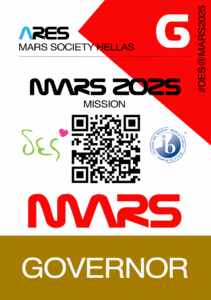DES@Mars 2025
Grades 4-6: Colonial Tensions and Governance
DES@Mars 2025 is an Interactive Analog Simulation exercise for the elementary school grades. The students acting as astronauts through an holistic experience can test and improve their abilities in STEAM activities, while as in social skills – leadership & team working – each to the common and their own benefit.

- Grades 4-6: Colonial Tensions and Governance: In the second axis, students engage with a more complex narrative: a geopolitical conflict between Earth authorities and Martian settlers. As Earth-based corporations begin to monopolize Martian resources without fair compensation, tensions rise. Feelings of economic exploitation and distant governance stir resentment among colonists. This growing discontent may spark a rebellion, as Martians push for independence, equitable economic systems, and self-governance—raising profound questions about justice, autonomy, and the future of interplanetary society. A ‘Treaty of Peaceful Coexistence’ between Mars & Earth was about to be signed & acceptance of the ‘Mars Declaration of Independence’ while as the Mars Free Radio was broadcasting towards Mars independence.
In case of problems – Martian government assembles the Mars Emergency Council.
ACTION TASKS
Task 1: Sign the ‘Treaty of Peaceful Coexistence’ between Mars & Earth was about to be signed & acceptance of the ‘Mars Declaration of Independence’.
Task 2: Silence the Mars Free Radio
- Persuade the Mars Free Radio to stop broadcasting messages that will destroy the cooperative spirit.
Task 3: Vote for the Peaceful Coexistence between Mars & Earth
- In case of disputes and arguments between Martians and Earthlings, the Martian’s government entitled spokesperson will gather the citizens and Earth’s Ambassadors for voting.
Mission Assessment
The mission success is based on the realisation of all required tasks, timing, motivation of the crew, quality of performed tasks and independence. At the end of the mission, students present their results on the summary meeting. Everyone elaborates the lessons learned. The Assessment takes place by utilizing the following rating model.
NASA 6-Es Rating Model
Each day or section of activities utilizes the 5-E Instructional Model (a constructivist learning cycle, helping students build their own understanding from experiences and new ideas). It has a growing research base and can be used within integration, Problem-based Learning (PBL), Project-based Learning (PjBL), and Universal Design for Learning (UDL). Included in this program guide is a sixth ʻEʼ for Excite. This additional ʻEʼ shows you how to incorporate NASAʼs unique information and resources to excite trainees with career connections, real world examples, spinoffs from NASA research and more.
- Engage: During this stage students are getting interested and personally involved in the lesson, while pre-assessing prior understanding.
- Explore: The purpose for this stage is to get students involved in the topic, providing them with a chance to build their own understanding.
- Explain: At this stage students have the opportunity to communicate what they have learned so far and figure out what it means.
- Elaborate: The purpose for this stage is to allow students to use their new knowledge and continue to explore its implications.
- Evaluate: Here both students and teachers to determine how much learning and understanding has taken place.
ARES
«Εις Άρεα»: «θάρρος χάρισέ μου μακάριε, να κρατιέμαι στους σωτήριους θεσμούς της ειρήνης, αποφεύγοντας τις μάχες με τους εχθρούς μου και τους βίαιους θανάτους».
Πυρόεις
Αφήλιο: 249.209.300 χλμ, (1,665861 AU), Περιήλιο: 206.669.000 χλμ. (1,381497 AU), Ημιάξονας τροχιάς: 227.939.100 χλμ. (1,523679 AU), Εκκεντρότητα: 0,093315, Περίοδος περιφοράς: 686,971 ημέρες, (1,8808 έτη), Συνοδική περ. Περιφοράς: 779,96 ημέρες (2,135 έτη), Μέση τροχιακή ταχύτητα: 24,077 χλμ./δευτ. 86.677,2 χλμ./ώρα, Μέση ανωμαλία: 19,3564°, Κλίση τροχιάς: 1,85061°(ως προς την Εκλειπτική) 5,65°(ως προς τον Ηλιακό ισημερινό), Δορυφόροι: 2 φυσικοί (Φόβος, Δείμος)

